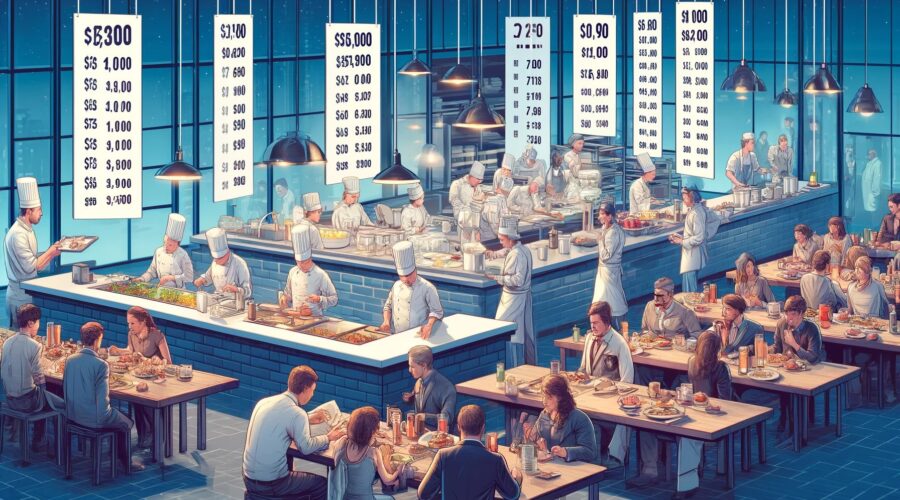Understanding Restaurant Labor Cost: A Comprehensive Guide
We all know that the restaurant industry operates on thin margins, where managing expenses can mean the difference between success and failure.
Nex to food cost, labor costs stands out as both significant and complex.
This comprehensive guide dives into what restaurant labor costs entail, how to calculate restaurant labor cost, and effective management strategies to optimize profitability while maintaining quality service.
What is Restaurant Labor Cost?
Restaurant labor cost refers to the total expense incurred by a restaurant to compensate its employees.
This includes wages, salaries, benefits, taxes, and any other compensations like overtime, bonuses, and tips (depending on the accounting practices of the restaurant). In the restaurant space, where staff engagement directly influences customer satisfaction, understanding and managing labor costs is crucial.
Labor cost is not just a line item on a financial statement; it’s a reflection of the restaurant’s operational efficiency, employee satisfaction, and ultimately, its bottom line.
From chefs and kitchen staff to servers and cleaners, every employee’s compensation contributes to the labor cost, making it one of the largest expenses for a restaurant.
How to Calculate Restaurant Labor Costs?
Calculating restaurant labor costs involves more than just adding up salaries and wages. To get an accurate figure, follow these steps:
- Total Payroll Costs: Start with the sum of all wages paid to employees, including salaries, overtime, bonuses, and other direct payments.
- Add Benefits and Taxes: Include the cost of employee benefits such as health insurance, retirement contributions, and any other perks offered. Also, add employer-paid taxes like Social Security, and unemployment taxes.
- Consider Non-wage Labor Costs: Account for any additional labor-related expenses, such as training costs, uniforms, and meal allowances.
The formula to calculate total restaurant labor costs is:
Total Restaurant Labor Cost = Total Payroll + Benefits and Taxes + Non-wage Labor Costs
This formula gives a complete view of the actual cost of labor to the restaurant, providing a basis for further analysis and management strategies.
Let’s dive deeper into the nuances of restaurant labor costs, exploring the labor cost percentage, its calculation, and broader implications for financial management within a restaurant setting.
What is the Restaurant Labor Cost Percentage?
Just like the food cost percentage, the restaurant labor cost percentage is a metric that represents labor costs as a percentage of total sales.
This metric helps owners and managers understand the efficiency of their labor expenditure relative to the restaurant’s overall revenue. A lower percentage suggests a leaner labor operation relative to sales, while a higher percentage indicates that labor costs are consuming a larger portion of the restaurant’s income, eating away profits.
Understanding this percentage is vital for budgeting, forecasting, and operational adjustments, especially in an industry known for fluctuating sales volumes and intense competition.
How to Calculate Labor Cost Percentage?
Compared to sales
Calculating the labor cost percentage involves two key figures: your total labor costs (as previously calculated) and your total sales revenue within the same period. The formula is as follows:
Labor Cost Percentage= (Total Labor Costs / Total Sales Revenue) x 100
For instance, if a restaurant’s labor costs for a month are $10,000 and its sales revenue for the same month is $50,000, the labor cost percentage would be:
(10,000 / 50,000) x 100 = 20%
This means that for every dollar earned, 20 cents go towards covering labor costs.
Compared to overall expenses
Another popular way of calculating labor cost percentage is to compare it to the total overall expenses. This included overhead, marketing, utilities, ingredients, …
To compare labor cost to overall expenses, the formula looks like this:
Labor Cost Percentage = (Total Labor Costs / Total Operating Costs) * 100
Let’s take another look at the example from above:
The restaurant has a labor cost of 10.000. Besides labor, it has spent 27.000 on ingredients, marketing, overhead, …
Labor Cost Percentage = (10.000 / 27.000) * 100 = 37,03%
What Overall Expenses are Attributed to Labor Costs?
Beyond the straightforward salaries and wages, several other expenses contribute to a restaurant’s total labor costs:
- Benefits: Health insurance, retirement plans, and paid time off.
- Taxes: Employer contributions to Social Security, Medicare, and unemployment insurance.
- Training: Costs associated with onboarding new employees and ongoing training programs.
- Uniforms and Equipment: Expenses for providing uniforms or special equipment required for staff.
- Employee Meals: Many restaurants offer meals to staff during their shifts, adding to the labor cost.
These components underscore the complexity of labor costs and the need for meticulous management.
What is a Good Labor Cost Percentage?
An “ideal” labor cost percentage varies widely by type of operation, location, and other factors.
A general benchmark for full-service restaurants is between 30% to 35% of total sales, while for quick-service restaurants, it can range from 25% to 30%. These figures can serve as a starting point, but it’s essential to measure and optimize and to find a good balance between cost and guest experience .
How to Manage Restaurant Labor Costs?
Effective labor cost management involves a combination of strategic planning, operational efficiency, and continuous monitoring.
Here are key strategies:
- Optimize Scheduling: Use sales forecasts and historical data to create schedules that align staff levels with customer demand.
- Improve Employee Retention: Investing in staff training and fostering a positive work culture can reduce turnover and associated hiring costs.
- Leverage Technology: Implementing a modern POS system or labor management software can provide insights into labor cost trends and inefficiencies.
- Monitor Labor Cost Percentage Regularly: Regularly review this metric to identify trends and areas for improvement.
Maybe a controversial move, but restaurants are even considering adding a labor fee to customer bills.
Getting started
If you’re ready to tackle your restaurant’s labor costs, a great place to begin is with our Labor Cost Calculator as it automatically calculates your labor cost percentage.
Simple to use and designed with the needs of restaurant owners and managers in mind, this template is your first step towards more efficient labor cost management.


